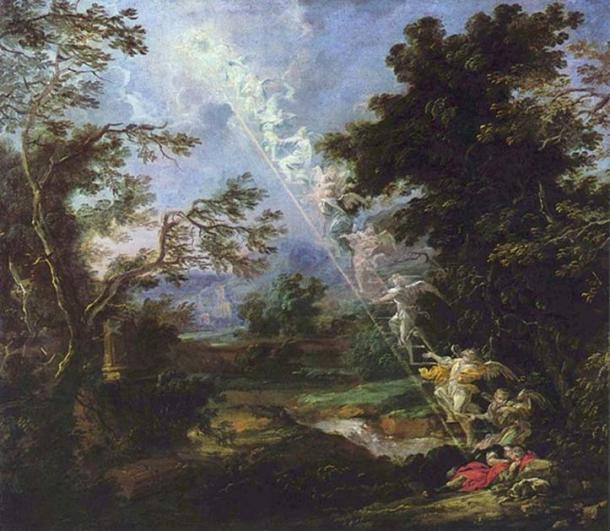
Hopes, Fears, Progress…and Maybe DNA? Unravelling the Real Meaning of Jacob’s Ladder
Jacob’s Ladder is the common term (particularly in the West) used to describe a bridge that connects Heaven and Earth. More broadly speaking, the ladder represents an ancient symbol of unknown origins that appears in cultures from Scandinavia to China and dates at least as far back as the civilizations of Mesopotamia. Today, some would argue the ladder symbol reflects ancient knowledge of DNA as well.
The Story of Jacob’s Ladder
This connection between the symbol of a ladder and an ancient understanding of DNA is most likely not true. However, Jacob’s Ladder does provide unique insight into how humans independently visualize the same symbol to express deeply felt hopes and fears.

"Landscape with the Dream of Jacob" showing the famous ‘Jacob’s Ladder’ (circa 1691) by Michael Willmann. (Public Domain)
It is widely held that images involving the ladder symbol “all derived from a common fountain of symbolism…The origin of the symbol was lost among the practices of the Pagan rites, while the symbol itself was retained, it is, perhaps, impossible authoritatively to determine” (Dafoe, 2007). The phrase ‘Jacob’s Ladder’ specifically refers to a dream of the Abrahamic patriarch Jacob in which he saw angels using a ladder to move between the two realms. Jacob “dreamed that there was a ladder [the Hebrew word here could also mean stairway or ramp] set up on the earth, the top of it reaching to heaven; and the angels of God were ascending and descending on it” (Gen. 28:12). The dream continues with God standing beside Jacob and promising that He will stay with Jacob and all his descendants. Jacob awakes and is exuberant with the love of God.
- Stairway to Heaven: The story of Jacob's Ladder
- The Descent of Inanna into the Underworld: A 5,500-Year-Old Literary Masterpiece
- Ancient Secrets Come into Sight: The Pineal Gland, Pine Cone Symbolism, and the Third Eye

‘Jacob’s Dream’ with Jacob’s ladder depicted as stairs (1557-1558) by Giorgio Vasari. (Walters Art Museum)
Most interpretations agree that the entirety of Jacob’s dream should be read as a sign of God’s favor toward the Jewish people. But it is the ladder itself that caught hold of public imagination.
Since then, the ladder metaphor has been used in the Judeo-Christian-Islamic zeitgeist to explain everything from the journey of the soul after death to the means by which Michael and Gabriel can communicate with humans. Some Hebrew scholars have maintained that the place where Jacob slept was the future site of the Temple of Jerusalem and the ladder represents the prayers and sacrifices that will cement God and Israel’s relationship. The famous scholar Philo of Alexandria (circa 50 AD) offered several theories as to the meaning of the ladder, including that it represented the ups and downs of life (virtue versus sin).
![]()
Icon – Jacob’s dream and ladder. (Ted/CC BY SA 2.0)
For Christians, the ladder represents Jesus, a bridge between Heaven and Earth. For Muslims, the ladder represents following the ‘straight path’ - that is, the essence of Islam.
Although Jacob’s Did, Not All Ladders Were Used to Go Upward
However, the ladder metaphor predates Jacob’s ladder, and is not exclusively Abrahamic. The earliest known instance of a clearly defined ladder symbol comes from the Babylonian legend of Ishtar’s descent into the Underworld by passing through seven gates (and even this may have been derived from an earlier Sumerian myth of Inanna descending into the underworld). The ladders do not always have rungs, but can at times be portrayed with steps, gates, or degrees, all of which indicate varying levels of proximity or distance.

Cylinder seal depicting the descent of Inanna. Credit: The Oriental Institute, University of Chicago. Unlike Jacob’s Ladder, which is represented with rungs or steps, Inanna/Ishtar passed through seven gates.
Seven is a commonly used number to indicate the levels of the ladder. Apart from Jacob’s Ladder, one of the best-known ladder myths is the Persian Mysteries of Mithras that describe the soul’s rise to perfection. “The candidate ascended a ladder of seven rounds, and also passed through seven caverns, symbolized by seven metals, and by the sun, moon and five planets” (Dafoe, 2007). In the Scandinavian version, the initiated climbs a tree. In the ancient Brahmin mysteries, the journeyer must pass through seven worlds, the first being the physical world of Earth and the seventh being the ideal Sphere of Truth. In the Eastern religions of Hinduism, Buddhism, and Jainism, life energy can be made to ascend through seven chakras.

The seven chakras in the body. Nepalese painting, 18th century. (Public Domain) Ascension isn’t always depicted with a ladder like Jacob’s; in Hinduism, Buddhism, and Jainism, for example, life energy can be shown to ascend through seven chakras.
It is amazing to see similar ladder imagery across space and time, but perhaps it should come as no surprise:
“Since the dawn of thought the ladder has been a symbol of progress, of ascent, of reaching upward, in many mysteries, faiths and religions. Sometimes the ladder becomes steps, sometimes a stairway, sometimes a succession of gates or, more modernly, of degrees; but the idea of ascent from darkness to light, from ignorance to knowledge and from materially to spiritually is the same whatever the form of the symbol” (Dafoe, 2007).
- The Royal Road of the King of the World, and the Ancient Center of the Earth
- 2000 Year Old Labyrinth Uncovered in India Shows Same Pattern as a Greek Maze from 1200 BC
- Legends, Mysteries, Light and Darkness: The Secret History of the Biblical Cave of the Patriarchs

A page from the facsimile edition of Burne-Jones' Flower Book, one of 38 watercolor designs reproduced by Henri Piazza et Cie, for the Fine Art Society, London in 1905. (Public Domain) While it is a rainbow, this ‘ladder’ is like Jacob’s Ladder, as it is also said to depict an ascension to heaven.
Did Ancient Ladders Like Jacob’s Represent DNA?
Recently, some have drawn parallels between the appearance of a ladder and the appearance of the DNA double helix. The commonality of ladder myths has been reinterpreted to suggest ancient or divinely inspired insight into the basis of human consciousness. A sample of such an argument is as follows: “The ladder of DNA that contains the light of God, via the chemical energy river of past life memories that flows through our bodily organs such as our brain into our Ammon's Horn, in order to access the inner Gnosis encoded in our very DNA Ladder” (Moe, 2013).
This theory is incredibly fascinating but most likely not true. It is generally accepted that the double helix, formed by pairs of nucleotides, was discovered by painstaking X-ray research in 1953. It is a wonderful coincidence that DNA has a shape of a ladder - but it is probably nothing more than that, a coincidence.

‘Jacob’s Dream (1805) by William Blake (left). (Public Domain) It is probably just coincidence, but in this representation the “ladder” appears similar in shape to one side of the DNA double helix (right). (tombaaaaa/CC BY NC ND 2.0)
Top Image: ‘Jacob’s Dream’ with Jacob’s ladder (1660-1665) by Bartolomé Esteban Murillo. Source: Public Domain
Sources:
Dafoe, Stephen. "Jacob's Ladder." Masonic Dictionary. Masonic Dictionary, 2007. Web. http://www.masonicdictionary.com/ladder.html
Genesis. New Oxford Annotated Bible. 4th Vers. Oxford: Oxford UP, 2010. Print.
Moe. "Jacob’s Ladder Decoded." GnosticWarrior.com. GnosticWarrior.com, 8 May 2013. Web. http://gnosticwarrior.com/jacobs-ladder.html

















Comments
You are correct, the ladder in Jacob's dream represents DNA. Think triple helix. But who's DNA?
You and this woman will hate each other; your descendants and hers will always be enemies.
One of hers will strike you on the head, and you will strike him on the heel." Genesis 3:15
Jesus said to them, “How then does David in the Spirit call Him Lord? For he says:
‘The Lord said to my Lord, “Sit at My right hand, until I put Your enemies under Your feet.”’
So if David calls Him Lord, how can He be David’s son?” Matt.22:44-45
The LORD said to my Lord: "Sit at My right hand until I make Your enemies
a footstool for Your feet." Psalm 110:1
"I, Jesus, have sent My angel to give you this testimony for the churches.
I am the Root and the Offspring of David, the bright Morning Star." Revelation 22:16
For unto us a child is born, unto us a son is given: and the government shall be upon his shoulder: and his name shall be called Wonderful, Counselor, The mighty God, The everlasting Father, The Prince of Peace. Of the increase of his government and peace there shall be no end, upon the throne of David, and upon his kingdom, to order it, and to establish it with judgment and with justice from henceforth even for ever. The zeal of the LORD of hosts will perform this. Isaiah 9:6-7
Jacob was the grandson of Abraham chosen to become one of the patriarchs of
a new nation - Israel - and the human line of descent for the Son of God/Son of Man
who would become spiritually lost humanity's needed redeemer.
For what the law could not do, in that it was weak through the flesh,
God sending his own Son in the likeness of sinful flesh, and for sin, condemned sin in the flesh: That the righteousness of the law might be fulfilled in us, who walk not after the flesh,
but after the Spirit. Romans 8:3-4